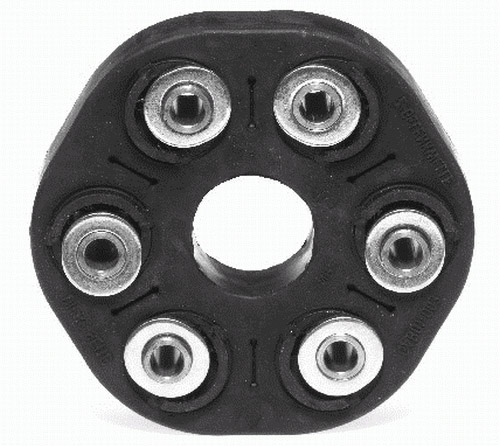 FLEXIBLE JOINTS – Their property is to allow only minimal angular deviations of the connected shaft parts, while the most important thing is shock absorption, occurring in the operation of the drive system. As a result, flexible joints are mainly used to protect other system components against overloads and vibrations, occurring inevitably during the operation of rapidly rotating mechanisms.
FLEXIBLE JOINTS – Their property is to allow only minimal angular deviations of the connected shaft parts, while the most important thing is shock absorption, occurring in the operation of the drive system. As a result, flexible joints are mainly used to protect other system components against overloads and vibrations, occurring inevitably during the operation of rapidly rotating mechanisms.
Rubber is almost always the load-absorbing and vibration-damping component in flexible joints, often reinforced with a textile matrix. The simplest example of a flexible joint is a disc made of fiber-reinforced rubber, to which the three-finger shaft ends are alternately bolted on both sides. This solution can work satisfactorily in slow-running machines, like for example. steering shafts. In fact, in propeller shafts (np. in the main shaft which transmits torque from the longitudinally arranged gearbox to the rear driving axle) flexible joints are used with a position radial to the shaft ends, with a steel spherical element, located in the sleeve of the second shaft. The complication of building such a joint is necessary, a results from the need for precise balancing of a rapidly rotating shaft. A poorly positioned and unbalanced flexible joint, due to its considerable size, it is a source of vibrations transmitted to the entire vehicle while driving, and maybe, against the constructor's intentions, not to prevent, and even increase the risk of damage to other elements of the mechanism (other joints and bearings).
A special case of the flexible joint is the Fiat driveshaft 126. It is a vulcanized metal-rubber structure that replaces the swing joint, which should compensate for the bending of the driveshaft, resulting from the transient position of the drive unit in relation to the axis of rotation of the rear control arm. Despite its massive build (or maybe partly thanks to her) Fiat drive joint 126 it gets damaged quite often. When the elasticity limit of the rubber that fills it is exceeded, it crumbles and falls out, increasing the play, and in the extreme case it disengages the drive.
Flexible hinges do not permit permanent torque transmission between the rotating shafts, whose axes are tilted more than a few degrees and in practice can then be used, when the shafts of the associated devices are coaxial, and the mountings of these devices are flexible. This is the case, for example, in. between the engine and gearbox on one side, and the main gear suspended to the body on the other.





